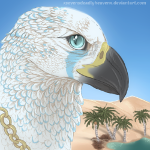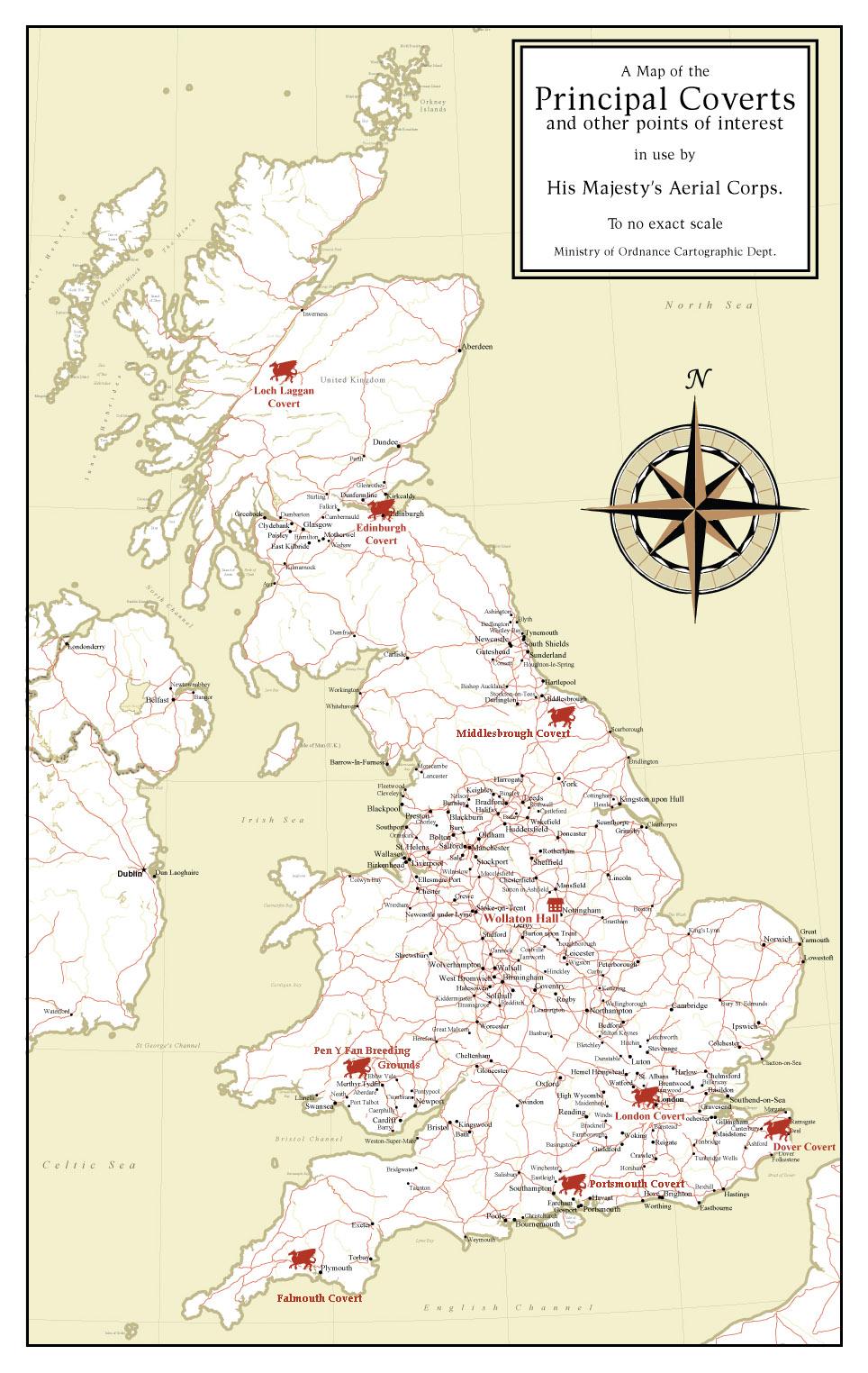Information On the Aerial Corps And Dragons
Run by the Aerial Command, the Corps is the branch of the British military which engaged in combat and other duties with dragons. The Aerial Corps uniform is much like the Royal Navy uniform, except Aviators have a bottle-green coat with bars instead of epaulettes, and they do not wear stockings and knee-breeches in battle. Aviators typically also wear a long oilskin overcoat, much like a duster along with goggles for flying.
The French equivalent is the Armée de l’Air.
Aviator
Members of the British Aerial Corps.
Prospective aviators were trained from the age of seven with the Corps, with the eventual goal of becoming captain to a dragon. Aviators became captains only if, given the opportunity, a dragonet allowed him or her to place the dragon in a harness. Once done, duty tied aviator and dragon together forever. As a result, aviators live an odd existence outside the traditional bounds of society, although the youth of good families were often given to the corps for training at age 7. Because of their long training and dedication, aviators do not welcome the prospect of anyone outside the Corps attempting to harness a dragon. Though it has happened. Newcomers often find it harder to adjust than those raised in the corps.
Aviators form an isolated society. Their mentality different from that of English society. Many of their practices would be judged as scandalous by the people. The first major difference was the treatment of women. Because some British dragons (e.g. Longwings) would only take female companions, British Corps allowed women to become Aviators. They even wear identical uniforms, which in this time is unthinkable. The presence of women in the Corps had to be kept secret to avoid a scandal.
The second difference was the relaxed way in which aviators thought about family. They engaged in informal relationships, but few of them ever married. It was expected of unmarried women to produce children for the Corps. The larger the dragon the longer its lifespan tends to be. They bond better with new Captains that are related to their old, bonding over shared pain. Thus they breed themselves as much as their dragons in some respects.
The last issue is the attitude towards dragons themselves. People often thought of them as savage and dangerous, and that it's best to keep them as far away as possible. However, the life of the Corps revolved around them. Dragons are cared for and admired as they symbolized power and respect. Unfortunately, when a dragon was unable to fight, it lost this status and was removed to the breeding grounds. If it was hatched with a deformity it was put to death. However, it has to be said that most British aviators are very loyal towards their dragons, to the point that they are judged by how well they tend to their dragon. Neglecting it or being cruel often leaves one alone and disdained by other aviators and dragons alike.
Even though the society isn't aware of how aviators really live, they are looked down on and often thought to be as savage as the dragons. Becoming an aviator is NOT considered a respectable career by society in many regards. Aviators can often be cold to outsiders and protective of each other and especially their dragons.
Captains of the aerial corps are forbidden from dueling. This was because if a dragons Captain dies it can become unmanageable or enraged. The same thing can happen in combat. Thus it is unwise to kill another dragons Captain and prefer to Capture the enemy dragons Captain so the dragon will be obedient for the sake of keeping it's Captain alive. A dragon will almost always choose and value it's Captain's life before any other, and is thus imperative that the Captain stays alive.
Aerial Corps Ranks
✦✦✦✦ Admiral
~ The highest ranking within the corps. They do not usually have dragons, those that did having gotten old and retired to the breeding grounds or lost them to battle and instead run plans and are in charge.
✦✦✦✧ Commodore
~ A rank just above captain, and just below Admiral. Not many receive this rank.
✦✦✧✧ Senior Captain
~ A rank above a Captain. Usually older and more experienced. May or may not have a dragon anymore
✦✧✧✧ Captain
~ Once you have harnessed a dragon, you are automatically placed in the rank of captain, as your dragon will not listen to anyone else but you. It doesn't matter if you're 15 or 50.
✧✧✧✧ Lieutenant
~ Second in command, and often next in line when it comes to a dragon hatching if there are no available Captains depending on number (1st, 2nd, 3rd lieutenant ect.)
✧✧✧ Midwingman
~ Just below Lieutenant. These are usually more seasoned in ways of dragons and have a large amount of experience. All are usually a part of the flight crew.
✧✧ Ensign
~ The second youngest groups, usually around 10 years old and up, and able to be a part of the flight crew.
✧ Cadet
~ Lowest ranks. Usually starting at 7 years old. Cadets usually remain a part of the ground crew for training and learning until around 10 years old, where they might be promoted
Aerial Corps Duties and Positions
Bellmen
- The crew on the lower rigging during a dragon's flight. Generally junior officers such as midwingmen, they were responsible for managing the harness and other equipment.
Lookouts
- Responsible for keeping watch during a dragon's flight. They informed the captain of enemy positions and incoming signals. They were generally ensigns, the youngest officers except for the cadets.
Riflemen
- Positioned as needed on the dragon during flight to fight off the enemy, including boarders. They were generally young, junior officers, such as midwingmen.
The usual weapon of riflemen is the Baker rifle, a revolution in firearms design. Until the introduction of the rifle, guns had barrels that were internally smooth. Rifling the barrel, i.e., putting a spiralling groove down its internal length, made the bullet spin in flight, greatly improving accuracy. This accuracy was vital in dragon-to-dragon fighting, where massed, inaccurate musket fire was impossible.
Runners
- Particularly favored cadets served as messengers and completed errands for the more senior officers. The runners were the youngest members of the flight crew. They could be as young as ten years of age.
Topmen
- Stationed on the upper rigging during a dragon's flight. They were generally junior officers, such as midwingmen, and had a variety of responsibilities, including protecting the captain from boarders. This was necessary because if the captainis captured, the dragon would surrender to save the captain's life.
Signal-Ensign
- Responsible for mastering and using the complex system of flag signals that are critically important for communication between dragons, especially during battle. They are generally young, junior officers, with the rank of ensign.
Ground Crew
- This crew is a part of a dragon's crew that remains on the ground. These positions include: Ground crew chief, Armourer, Armourer's mate, Leatherworker, Gunner, Harness-men, and Surgeons.
One of the unique features of the Aerial Corps is that rank is determined not only by the holder's ability, experience and record of service but also by whether or not they've harnessed a dragon and by that dragon's status among other dragons. A 14-year-old who's harnessed a Winchester or Greyling dragonet is a Captain and as such outranks the first lieutenant of a heavyweight, even though the latter is almost certainly older and has more experience in the Corps.
On the other hand, precedence among captains is determined by the native hierarchies among their dragons, which depends on factors such as size, special abilities and experience. On the battlefield, dragons will instinctively recognize the authority of a Regal Copper with a 20-year-old captain much more readily than that of a Winchester handled by a veteran officer. There is no point arguing with the dragons, so it is the humans who must adapt.
The larger dragons will instinctively prefer to fight with another dragon that is in it's own combat weight. A larger dragon fighting a lightweight will often find it unfair and be not as eager to fight than if it was fighting one of it's own size.
Dragon rigging
In the British Aerial Corps, combat dragons are fitted with several types of harnesses, including a light duty harness, travelling harness, and heavy combat harness. The harnesses consists of thick leather straps held together with large metal rings. On the belly of the dragon, the harness consists of a net (referred to, unsurprisingly, as the 'belly-netting') in which bombs, gunpowder, and some of the crew are kept.
The Crew travels from place to place upon the back of the dragon by means of a series of carabiner hooks and rings: the crew member would unclip the hook (attached to their belt) from the ring, move forward (or backwards, sideways, etc...), and re-clip the carabiner to carabiner when they have reached their location. If moving a relatively long distance across the dragon, you would unclip and re-clip several times. While this method is rather slow and tedious, you remain attached to the dragon's harness most all of the time, which is extremely important should the dragon perform a maneuver such as a roll. Such a maneuver would result in many of the crew falling off the back of the dragon if they were not held on by their carabiners. Crews are trained as vigorously as the dragons so that maneuvers of the men are as smooth and well trained and aren't hindered by the maneuvers of the dragons themselves.
Harness fitting and rigging is the responsibility of the dragon's ground crew, with the main responsibility falling upon the harness-tender.
Formation
In the Aerial Corps, dragons often fly in formation. This is one of the few duties that can be taught by a riderless dragon. Other nations have different formation flying styles. Formations combine the advantages of protection and organisation with the disadvantages of predictability. As such formations can be exploited to their detriment.
For British formations. It is not uncommon for the longwing to be the formation leader, their acid spitting ability making them some of the most valuable dragons, able to eat through metal of guns, skin of soldiers, and the wood of ships alike. The rest of the formation created and formed in way of protecting and defending the longwing in battle.



 0 players like this post! Like?
0 players like this post! Like? 

 0 players like this post! Like?
0 players like this post! Like?

 0 players like this post! Like?
0 players like this post! Like?

 0 players like this post! Like?
0 players like this post! Like?

 0 players like this post! Like?
0 players like this post! Like?



 0 players like this post! Like?
0 players like this post! Like?

 Report
Report
